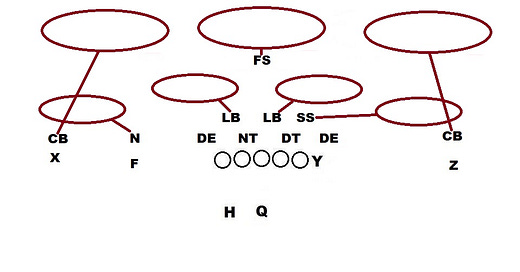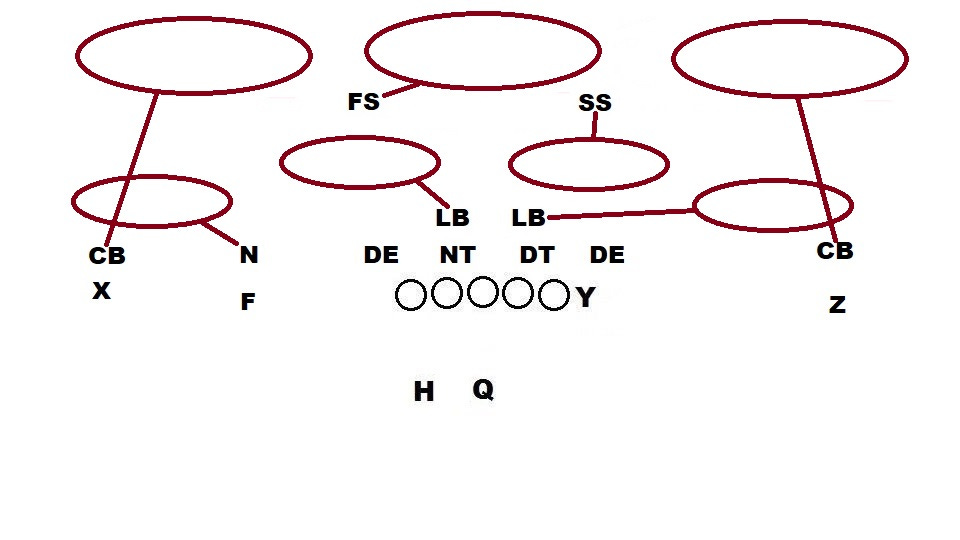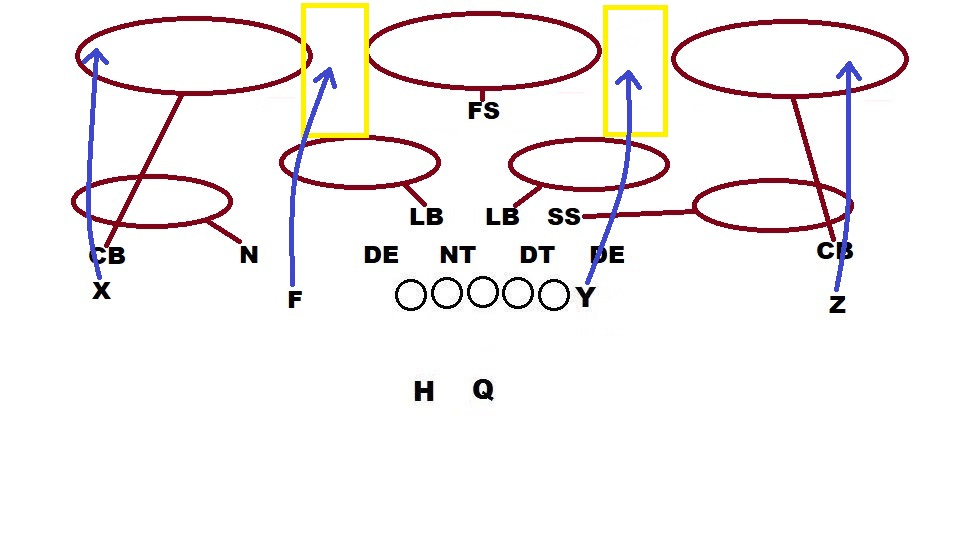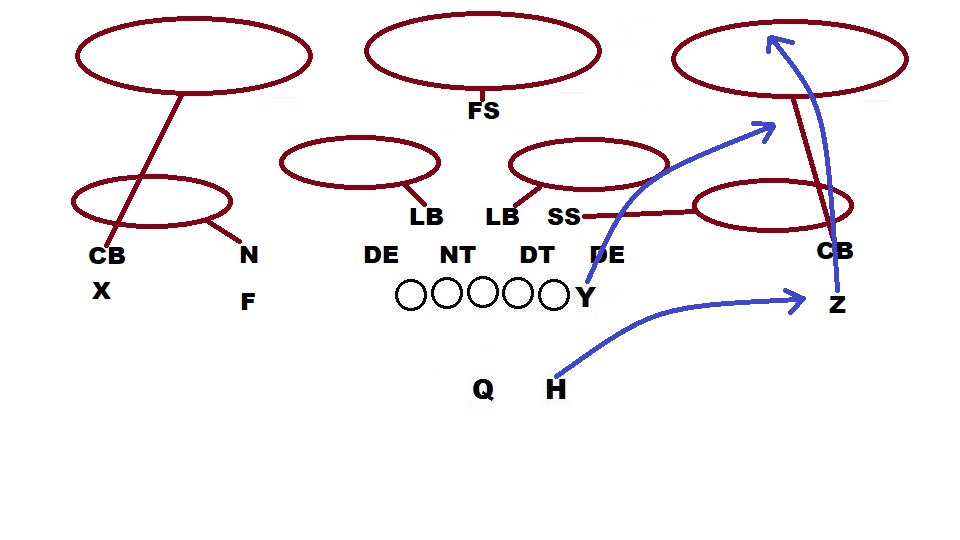Washington Coverages Part 1: Cover-3
The first in a three-part series looking at what coverages Washington's secondary could use this season with the new personnel.
An often overlooked storyline to the Washington Football Team’s offseason is the turnover in the secondary. While Washington’s defense is the strength of the team, that generally comes from the depth of talent along its defensive line. The Linebacker group was seen as a weakness entering the offseason and Washington addressed that by drafting Jamin Davis in the first-round, but the secondary is often forgotten about.
The secondary has perhaps seen the most change since this time last year. At cornerback, Washington entered the offseason with two solid corners in Kendall Fuller and Ronald Darby, both free agent acquisitions from 2020. Behind them, Jimmy Moreland had some ups and downs playing in the slot and Fabian Moreau was the next most recognisable corner on the roster, as Washington’s third-round pick back in 2017.
However, both Darby and Moreau were free agents and left to join the Broncos and Falcons respectively. Washington replaced Darby by signing William Jackson III from the Bengals, who many see as an upgrade on Darby. The team also drafted corner Benjamin St-Juste out of Minnesota in the third-round, rounding out the corner group.
At safety, 2020 seventh-round pick Kamren Curl had a fantastic season as a rookie and developed strongly down the stretch filling in for the injured Landon Collins at strong safety. Washington should be boosted by the return of Collins this season, but both he and Curl excel in the strong safety role. Free safety wasn’t fully addressed in the draft or free agency until the Dolphins cut Bobby McCain, who Washington signed after the draft to a cheap one-year deal.
So with all this turnover, how exactly will Washington’s secondary shape out in 2021? That’s what I’ll be looking to answer in this three-part series. So where do we start?
First, we should look back at what Head Coach Ron Rivera and Defensive Coordinator Jack Del Rio did with the secondary in 2020. Teams very rarely undergo drastic changes in scheme from year to year when the same coaching staff remains in place, but rather more small details to adjust the scheme to fit the new personnel.
Last season, Washington played a lot of zone coverages, mainly Cover-3 and quarters. ESPN’s Matt Bowen tweeted out some coverage stats after Week 12 last season which I found interesting.

Washington used Cover-3 32.7% of the time, fourth most in the league. Obviously there was still a few games left to play in the season, but its likely Washington finished playing Cover-3 at least 30% of the time last year. That gives us a good place to start when looking forward to next season.
Cover-3
Cover-3 made a resurgence in the early 2010’s thanks to the Seattle Seahawks. As its name suggests, it’s a three-deep zone coverage that splits the deep part of the field into thirds, each assigned to a single defender. Underneath, the rest of the defense splits the field into four parts. On paper, it should look something like this:
The most basic form of Cover-3 sees the two outside cornerbacks sink back to cover the deep outside thirds on their side of the field while the free safety takes up the deep middle of the field. The underneath four zones consist of two middle hook-curl zones and two curl-flat zones on the outside.
Different teams like to mix up which defenders play which zones, with the strong safety often switching zones depending on pre-snap alignment. In this diagram, the strong safety is in the box and works out to the flat, but often teams like to switch it up by having that safety start deep as part of a two deep safety look.
This gives the offense and particularly the quarterback something different to think about, as the safety rotation changes from a two deep safeties pre-snap to a single deep safety post-snap. A lot of coverage reads for quarterbacks are based on the number of deep safeties, so if a quarterback gets lazy with safety rotation post-snap, this can be a nice change up. This variation is known as Cover-3 Buzz, as the safety starts deep before buzzing up into the underneath zone, while the linebacker has to race outside to cover the flat.
But regardless of how they get there, it results in the same areas of the field being covered. It’s a simple, basic scheme that is easy to understand and execute.
Strengths and weaknesses
Cover-3 has remained very popular around the league for a while now. It’s a fundamentally sound coverage that is relatively safe against deep shots while also allowing the defense to play with a single deep safety. That enables the defense to rotate the strong safety down into the box, giving them an additional run defender. From a numbers perspective, it's a scheme that allows the defense to be safe in coverage while also having enough defenders in the box to fit the run securely.
However, with so many teams playing Cover-3, offenses around the league have installed various Cover-3 beating concepts. The two main ways teams try to attack Cover-3 is in the seams and with floods.
Four verticals is one of the most common counters to teams that play Cover-3 regularly. Four verticals is exactly what it sounds like, four receivers all running vertical routes down the field. This is a problem for Cover-3 teams because they only have 3 defenders covering deep, meaning if the spacing is correct by the offense, then the defense should be outnumbered. Typically this would be in the seams, where the free safety is in a no-win situation with a receiver either side of him.
Cover-3 teams counter this by having certain rules and checks built into the scheme to protect the defense from being overloaded deep. These rules and checks are dependent on how the offense runs it’s four verticals. If they run it from a two by two formation like we saw above, then one of the underneath defenders, typically the strong safety or the nickel corner, would attach to one of the seam routes and carry it down the field, allowing the free safety to work to the other side of the field. If the offense runs four verticals from a trips formation, with the inside receiver crossing the field on a deep over, then the rule is slightly different.
That deep over from the inside receiver is tough to defend, especially if the deep safety has to also worry about the slot receiver running up the seam. The common way to defend it, and one which Washington uses, is to have the linebacker use what’s often known as a robot technique. Washington’s first-round pick, Jamin Davis, executes the technique perfect in this example, apart from running into the referee…
The technique asks the linebacker away from the three receiver side of the field to turn and run with that deep over route. It requires that player to be completely blind to the quarterback, but if they turn and run well, they can sink underneath the route and either take it away from the quarterback without having to worry about finding the throw, or secure the route and read the receiver for hints the ball might be coming before sticking an arm out to defend it.
The other common way to attack Cover-3 is with a flood concept. This sends three receivers to the same side of the field, attacking the defense on three separate levels; deep, intermediate and underneath.
As you can see, the defense is overloaded, or flooded, with three receiver attacking three separate parts of the defense to one side. The defense only has a deep defender and a flat defender, which should leave what’s known as the sail route from the tight end wide open. One counter to this for Cover-3 teams is to have the flat defender play a sail technique, meaning while they drop to the flat, they get their eyes inside on any potential sail route. If a receiver runs the sail route, the flat defender then sinks back underneath it to take it away, forcing the throw to the flat where the rest of the defense can rally to the ball and keep the gain to a minimum.
Kam Curl demonstrated a good example of this sail technique early in the season last year when he was playing Washington’s Buffalo nickel role.
The Browns don’t have a receiver working into the flat on this occasion, but the rest of the concept is the same. Curl is highlighted in red, while the rest of the defense plays Cover-3. Curl works out to the flat initially, but adjusts his body inside to get eyes on the slot receiver and read his route. As soon as the slot receiver breaks outside on the said route. Curl sinks back to take it away, forcing the quarterback to scramble.
Fit with Washington’s personnel
There are some positives and negatives to how Cover-3 fits with Washington’s personnel, particularly with the secondary. From a positive perspective, it allows the strong safety to be in the box more, which suits both Kam Curl and Landon Collins. Neither of them are really suited to playing the deep middle role, though both could play it from time to time to keep teams honest, but in general both are better closer to the line of scrimmage where they can make a bigger impact.
New safety Bobby McCain played as a single high safety for the Dolphins last season. The Dolphins played mostly Cover-1, which is a man coverage, but the free safety has a similar role. McCain has good range and ball skills, which should make a transition to Washington’s Cover-3 relatively easy for him.
The questions with Cover-3 for Washington come at corner. Kendall Fuller is a strong zone corner that suits playing off and with vision. That way he can use his cushion to read both the quarterback and the route combinations, allowing him to decipher the play and break on the ball. However, new additions William Jackson III and Benjamin St-Juste are different types of cornerback. Both are long, physical corners that play best up on the line of scrimmage, jamming the receiver at the line to disrupt their release.
In Seattle’s version of Cover-3, the cornerbacks were asked to play physical press coverage at the line of scrimmage. They targeted long, athletic corners like Richard Sherman and Byron Maxwell that could be physical at the line but also peel off and sink back into the deep third when needed.
This is a good example of that Seahawks Cover-3 scheme, with Sherman and Maxwell up on the line of scrimmage pressing the outside receivers while the rest of the defense drops into a typical Cover-3. Sherman in particular, at the top of the screen, presses his receiver with a physical jam at the line of scrimmage and then takes a man-turn, meaning he turns his back to the quarterback while running with the receiver down the field. He secures the route then gets his head back around to locate the ball and pull in the interception.
At the bottom of the screen, Maxwell starts in press but bails out at the snap of the ball. Often the Seahawks had Maxwell press his man too, but at times either he or Sherman, or sometimes both, would open their hips inside and sink back with vision on the quarterback as the ball is snapped.
The press coverage adjustment could be something Washington uses to accommodate Jackson and St-Juste. To execute that press adjustment well, the press corner has to be alert to the rules of his coverage. If the receiver runs underneath or breaks off his route early, then the corner has to be prepared to peel off and sink back into their deep third.
That adjustment wouldn’t necessarily suit Fuller’s game. Fuller could kick inside to the slot in nickel packages, where he made a name for himself when he was first drafted by Washington, but he’ll likely remain on the field as the outside corner in base packages. In any situation Fuller plays outside, he could simply do what Maxwell did on that play and bail out, allowing him to play off and with vision while Jackson plays press on the other side.
Some defenses do allow the corners to pick their preference in terms of alignment. That’s why you’ll see some teams with the outside corner on one side of the field up on the line of scrimmage in press coverage, which the corner on the other side of the field will be eight yards off the line of scrimmage. This could be the compromise for Washington when it comes to running Cover-3 with this personnel. Jackson could be allowed to play physical press coverage on the line of scrimmage, at least until he’s needed to sink back and fill his deep zone responsibilities, while Fuller plays off the line of scrimmage on the other side.








Very technical - well explained and fitted to the existing personnel.
I would like to send some of your articles to an old Redskin pal of mine who is not familiar with your writing. Can you send him some of your articles on the current goings on with the WFT? His name is Terry Murray and his email address is "tcmurray43@gmail.com".